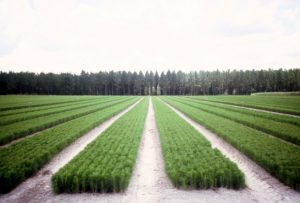Which Pine is Best?
If you have plans to plant southern pines on your property, you have some important decisions to make:
- Which species is most appropriate for your site and objectives?
- What is the best available genetic variety of the pine species you are interested in planting?
Species
Loblolly, slash, and longleaf pines are the most commonly planted species of pines in Florida. You will want to consult with your county forester or a consultant about your particular site(s) but here are some very basic rules of thumb on species and site:
- Slash pine (Pinus elliottii) grows well on moist, sandy savannah and flatwoods soils.
- Longleaf pine (Pinus palustris) grows well across a broad range of sites but is more competitive with the other species, growth-wise, on drier upland sites like sand hills.
- Loblolly pine (Pinus taeda) grows very well on loamy soils of drainages or lands suitable for agriculture. Abandoned crop lands that were once good producers of crops grow loblolly well. Clay soils are also good loblolly sites. Of all the pines, loblolly pine responds the best to fertilization.
In addition to site considerations, you should consider which species fits best with your land management goals. If timber production is a primary goal, slash or loblolly pine is generally a good fit on their respective sites. if wildlife and habitat restoration is a goal, longleaf pine is often a very good fit because prescribed fire can be used when the trees are very young. Also, the open crowns of longleaf allow the most sunlight through to promote a productive, herbaceous forest floor. If balancing timber and wildlife, consider how early you wish to use prescribed fire. If you wish to burn early, within the first 3-4 years of the stand, longleaf is best adapted to fire and the best choice.
Genetics

Planting genetically improved varieties of pines can increase the productivity, health and value of timberlands. Genetically improved varieties of pines can be purchased from forest tree nurseries. Just as farmers plant the best-available varieties of crops that have been developed through many generations of breeding, forest landowners should plant the best-available genetically improved varieties of pines for their timberlands.
Tree-improvement breeding programs have the same goal as animal and plant breeding programs:
- Develop genetically improved planting stock that produces healthier, higher-yielding, and higher-valued plantations; and
- Maintain a broad genetic diversity within each new variety to help buffer the variety against the varied and changing environments of a long plantation life.
To learn more about Genetically Improved Pines, see http://edis.ifas.ufl.edu/fr007
Learn more about forest stewardship and the Florida Forest Stewardship Program
 0
0
